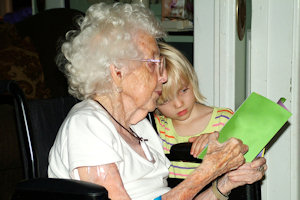Kinship placement is a growing priority in foster care throughout the U.S.
When a child can no longer live with his or her birth parents, the state prefers placing the child in the home of a relative or friend instead of a non-relative foster home. This, ideally, will ease the trauma of separation from birth parents while providing a safe environment for the child to live in. It’s a shift in foster care that, according to supporters, has obvious benefits.“It is undeniable that the practice of kinship care can benefit children in unfortunate situations for a variety of reasons, including enabling the child to maintain ties to its family and encouraging family preservation,” Lindsey Housman said in a Seton Hall report titled “A Cautious Approach to Kinship Legal Guardianship in NJ.”
But what happened when a child lived in the care of kin on a long-term basis without court approved legal guardianship? What happened when that caregiver wanted to make decisions about the child’s education and healthcare? In most cases in the past, caregivers could not make those decisions because the child’s biological parent’s rights were not terminated. NJ needed another option for those children and caregivers. That’s why New Jersey created Kinship Legal Guardianship (KLG).
KLG, which became effective in NJ in 2002, is a permanent placement option that can be considered for a DCP&P supervised child after adoption has been ruled out and if the child has been living with a kin caregiver for at least 12 consecutive months, or 15 of the last 22 months, due to parental incapacity.
KLG was created because the state “recognized that there was an increase in the number of children who, for a variety of reasons, could not live with their parents as well as an ‘increasing number of relatives who found themselves providing care on a long-term basis to these children without court approved legal guardianship status because the caregivers either are unable or unwilling to seek termination of the legal relationships between the birth parent and the child,’” according to Housman’s report.
The state saw it necessary to create an alternative permanent legal arrangement for kinship caregivers that would be beyond custody without rising to the level of termination of parental rights.
A caregiver can become a Kinship Legal Guardian if:
• The child’s parents are incapacitated and cannot take care of the child
• The child has been living with the caregiver for at least the last 12 months
• The caregiver can show that it is in the child’s best interests to stay with him/her
• The caregiver is biologically or legally related to the child or is a family friend
• The caregiver is financially eligible.
However, KLG can only be granted by a court order and it has to meet two specific criteria, according to DCP&P. First, adoption by the kin caregiver or anyone else is not likely. Secondly, the placement with the kin caregiver must be in the child’s best interest.
While the kinship legal guardian is responsible for the care and protection of the child until adulthood, KLG does not terminate parental rights. Parents retain the right to visit as well as the authority to consent to the child’s adoption and change of name if that option becomes available.
A parent can ask the judge to end KLG and return custody of the child if she or he can present evidence that the parent’s incapacity no longer exists, the kinship legal guardian is unable to care for the child or KLG is no longer in the child’s best interest.
KLG ends when the child turns 18 or is no longer continuously enrolled in a secondary education program or when the child no longer lives with the kinship legal guardian. The court can also terminate KLG for other reasons.
Although KLG is a relatively new practice, supporters argue that it has many benefits, maybe none as important as providing stability while preserving family ties.
“One of the most prevalent arguments for KLG is that it encourages family preservation,” Housman wrote. “Since no termination of parental rights is required by ASFA when a child resides with a relative and the child is living with a caregiver with whom it shares an emotional bond and has likely known its entire life, KLG enables a child to maintain ties to its family.”

